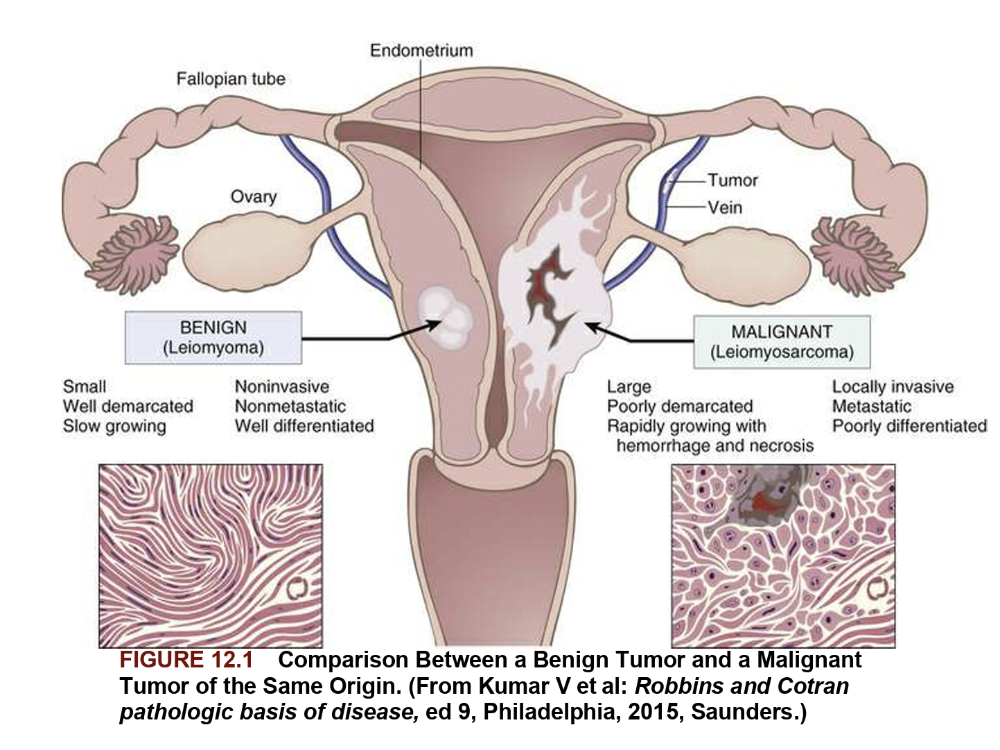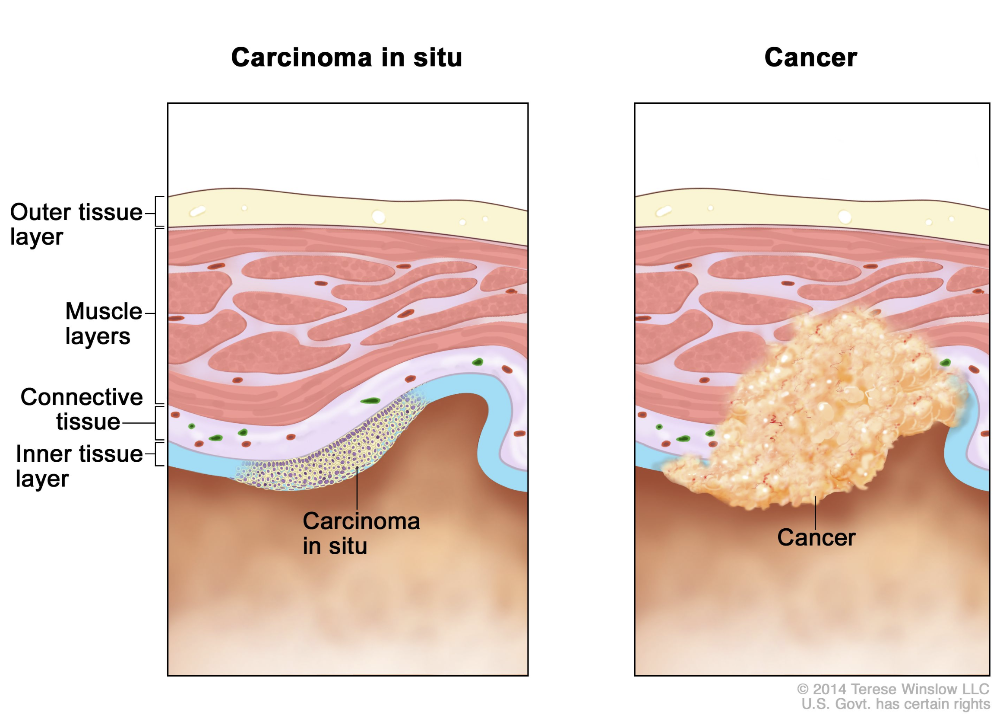Benign Tumors Characteristics'
Growth?
Is it easily Differentiated?
Capsule?
Invasive? Does it Metastisize?

- Slow growth
- Well-defined capsule
- Not invasive
- Well differentiated
- Does not metastasize
- benign tumors can become extremely large and, depending on
their location in the body, can cause morbidity or be
life-threatening by
compressing normal tissue, preventing blood flow to the region
(ischemia), or causing necrotic death of normal tissue- menigioma can compress against brain structures
- Benign tumors of endocrine organs may lead to overproduction of hormones
- Benign tumors of the colon
or stomach usually present as colonic or
gastric polyps, and those of melanocytes present as dark-colored nevi
(e.g., birthmark, mole).
Benign Tumors Naming
- Are named according to the tissues from which they arise and include the suffix, -oma.
- Lipoma: Fat
- Leiomyoma: Smooth muscle
Malignant Tumors Characteristics
Growth?
Is it easily Differentiated?
Capsule?
Invasive? Does it Metastisize?

- Rapid growth
-
Not encapsulated
-
Why do they lack a capsule?
- Malignant tumors lack a capsule and grow to invade nearby blood vessels, lymphatics, and surrounding structures.
-
Why do they lack a capsule?
- Invasive
-
Poorly differentiated: Anaplasia
- One of the
microscopic
hallmarks of cancer cells are anaplasia, the loss of cellular
differentiation - pleomorphic: vary in size and shape
- One of the
microscopic
-
Can spread distantly (metastasis)
- most important
and deadliest characteristic of malignant tumors
is their ability to spread far beyond the tissue of origin, a process
known as metastasis
- most important
and deadliest characteristic of malignant tumors
Classification and Naming of Malignant Tumors
Malignant tumors naming
-
Are named according to the tissues from which they
arise
-
Adenocarcinoma: Ducts or glands
- Cancers of lymphatic tissue: Lymphomas
- Cancers of blood-forming cells: Leukemias
-
Adenocarcinoma: Ducts or glands
- Malignant epithelial tumors: Carcinomas
- Malignant connective tissue tumors: Sarcomas
- Cancers arising from mesenchymal tissue (including
connective
tissue, muscle, and bone) usually have the suffix sarcoma- cancers of skeletal muscle are
known as
rhabdomyosarcomas
- cancers of skeletal muscle are
known as
Carcinoma in situ (CIS)
What are they?
Are they malignant?
Prognosis ?

Carcinoma in situ (CIS)
- Are preinvasive epithelial malignant tumors of glandular or squamous origin
-
Have not broken through the basement membrane or invaded the
surrounding stroma
- early stage cancers are localized to the epithelium
- Are not malignant
- Three prognoses: "S.M.D."
- Can remain stable for a long time
- Can progress to invasive and metastatic cancers
- Can regress and disappear
- CIS occurs in a number of sites, including the cervix, skin,
oral
cavity, esophagus, and bronchus - CIS can vary from
low-grade to high grade
dysplasia, with the high-grade lesions having the highest
likelihood of becoming invasive cancers
Oncogenes and tumor suppressor genes **
What role do they play in human carcinogens?
- Three key genetic mechanisms have a role in human carcinogenesis.
- Activation of proto-oncogenes, resulting in hyperactivity of growth-related gene products (called oncogenes)
- Mutation of genes, resulting in the loss or inactivity of gene products that would normally inhibit growth (called tumor-suppressor genes)
- Mutation of genes, resulting in an overexpression of products that prevent normal cell death or apoptosis, thus allowing continued growth of tumors
Chronic Inflammation leads to Cancer?
- Chronic inflammation: Is an important factor in the development of cancer
- Active inflammation predisposes a person to cancer
- By stimulating a wound-healing response that includes proliferation and new blood vessel growth
- Chronic inflammations may result from many causes, for example, solar irradiation, asbestos exposure (mesothelioma), pancreatitis, and infection
- Successful tumors appear capable of manipulating cells of the inflammatory response from a rejection response toward the phenotypes associated with wound healing and tissue regeneration; a process that includes induction in the damaged tissue of cellular proliferation, neovascularization, and local immune suppression. These activities benefit cancer progression, as well as increase resistance to chemotherapeutic agents.
What are susceptible organs that are prone to inflammation leading to cancer?
- Susceptible organs
- Gastrointestinal (GI) tract
- Pancreas- pancreatitis
- Thyroid gland
- Prostate/Urinary bladder
- Pleura, skin
-
- Examples
- Those with ulcerative colitis for 10 years or more have up to a 30-fold increase in developing colon cancer
- Hepatitis B (HBV) or hepatitis C (HCV) increase the risk of liver cancer
Viral Associated Cancers
- Several viruses have been associated with human cancer
-
Human papillomavirus (HPV)
- HPV-16, -18, -31, and
-45 are highest risk for developing cervical, anogenital, and
penile cancer
- HPV-16, -18, -31, and
-45 are highest risk for developing cervical, anogenital, and
penile cancer
-
Epstein-Barr virus (EBV)
- Leads to B cell lymphoma in HIV immunocompromised individuals
- Burkitt lymphoma in areas of endemic malaria
- Nasopharyngeal carcinoma in Chinese Populations
- Hepatitis B (HBV)
- Hepatitis C (HCV)
Cancer Invasion
What are required cell abilities to spread?
- Metastasis: Is the spread of cancer cells from the site of the original tumor to distant tissues and organs through the body
- Is a complex process that requires cells to have many new abilities "SSPG"
- Spread
- Survive
- Proliferate in distant locations
- Destination must be receptive to growth of cancer
Clinical Manifestations of Cancer
- Cachexia
- Is the most severe form of malnutrition
- Leads to protein-calorie malnutrition and progressive wasting
-
Manifestations
- Anorexia
- early satiety
- weight loss
- anemia
- asthenia- weakness
- taste alterations
- altered protein, lipid, and carbohydrate metabolism
What is Diagnosing and Staging of Cancer
-
Diagnosing
- location of the cancer can determine
symptoms by physical pressure,
obstruction, and loss of normal function - cancer can cause problems far away from its source by pressing on nerves or secreting, bioactive compounds.
- once the diagnosis is suspected (from S/S) and a tumor has been identified, it is essential that tumor tissue be obtained to establish a definitive diagnosis
- location of the cancer can determine
symptoms by physical pressure,
- Staging
- determine if the cancer has spread, known as the stage of the cancer
- Involves the size of the tumor, the degree to which it has invaded, and the extent of the spread
- Stage 1
- Is confined to its organ of origin
- Stage 2
- Is locally invasive
- Stage 3
- Has spread to regional structures, ex lymph nodes
- Stage 4
- Has spread to distant sites
Tumor Markers
- Are substances produced by benign or malignant cells
- Are found on or in a tumor cell, in the blood, in the spinal fluid, or in urine
- Hormones
- Enzymes
- Genes
- Antigens
- Antibodies
Cancer Treatment
Surgery
- Surgery is often the definitive treatment of cancers that do not spread beyond the limits of surgical excision.
- Surgery also is indicated for the relief of symptoms, for instance, those caused by tumor mass obstruction. In selected high-risk diseases, surgery plays a role in the prevention of cancer
Radiation
- Radiation therapy is used to kill cancer cells while
minimizing damage to normal structures
- Radiation produces slow changes in most cancers and irreversible changes in normal tissues as well.
- Because of these irreversible changes, each tissue has a maximum lifetime dose of radiation it can tolerate.
- Radiation is well suited to treat localized disease in areas that are hard to reach surgically, for example, in the brain and pelvis.
- 125I-labeled capsules (also called seeds), can also be temporarily placed into body cavities, a delivery method termed brachytherapy. Brachytherapy is useful in the treatment of cervical, prostate, and head and neck cancers
Chemotherapy
- All chemotherapeutic agents attack pathways that exist in rapidly dividing normal cells, but cancer cells utilize more and are severely affected
- Single chemotherapeutic agents often shrink cancers Induction chemotherapy seeks to cause shrinkage or disappearance of tumors, but success depends greatly on the type of tumor, the stage, and the individual's age at diagnosis
- Chemotherapy may shrink the tumor and improve symptoms without ultimately providing a cure.
- Adjuvant chemotherapy is given after surgical excision of a cancer with the goal of eliminating micrometastases.
- Neoadjuvant chemotherapy is given before localized (surgical or radiation) treatment of a cancer.
- Neoadjuvant therapy can shrink a cancer so that surgery may spare more normal tissue
- ex bone cancer osteogenic sarcoma, neoadjuvant therapy often converts a large tumor mass into a much smaller mass, allowing the surgeon to perform a limb-sparing excision rather than an amputation